On the issue of intent, should David Mackay really be the one looking down the barrel of a lengthy suspension? Pictures: CHANNEL 7/ GETTY IMAGES
Priorities. Intentions. Contradictions. They’re three words which could sum up the issue of how AFL football deals with physical contact these days. And they’re being highlighted on almost a weekly basis.
You’ll hear them again on Thursday night when the AFL Tribunal sits to consider the case of Adelaide player David Mackay’s collision with St Kilda’s Hunter Clark, one which left the latter nursing a broken jaw and out of action for up to eight weeks.
Not for the first time recently, it’s being viewed as a test case for, as commentator Nick Riewoldt put it on Monday night: “determining the future fabric of the game.”
I wouldn’t go that far, personally. There’s been enough inconsistencies (or yes, contradictions) in football’s judicial findings over the years to assume one ruling isn’t about to create a precedent which will forever change the landscape of how particular situations are dealt with.
But there’s no doubt the AFL is backed into something of a corner on the Mackay case.
Sure, its intent to eliminate as far as possible serious head injuries and take a tough stance on players who cause them is noble. But it also sometimes simply can’t be reconciled with how a game involving physical contact and played at a high velocity pans out. And the Mackay incident looks a classic example.
Unlike the Patrick Dangerfield-Jake Kelly clash in round one or Carlton defender Lachie Plowman’s bump on Hawthorn’s Jaeger O’Meara a few weeks ago, which both resulted in suspensions, it’s a lot more difficult this time to mount a case that what Mackay did was anything other than a completely legitimate football act.
Both he and Clark moved towards a ball in dispute in exactly the same position, both with eyes on the ball, both with their hands outstretched and reaching for it. The St Kilda player got there a micro-second before his opponent, who instinctively turned not to hurt his opponent, but to protect himself.
If that is to result in any sort of suspension, let alone the three games-plus the AFL’s contention that it was “careless”, “high” and “severe” would normally grade it, we have a major philosophical conundrum looming.
Because this isn’t about “electing to bump” or “duty of care” so much as “no alternative”. Mackay simply didn’t have one, the realisation that it would be Clark who got there fractionally first and not he simply coming too late to avoid contact, and that resultant contact made only as Mackay sought to avoid his own injury.
It took the intervention of AFL football operations manager Steve Hocking to send this to the tribunal, the statement released by the league on Monday claiming: “The AFL acknowledges that such matters do not generally proceed on the basis of the general rough conduct prohibition under AFL tribunal guidelines, hence the direct referral to the tribunal.”
In other words: “We know that what Mackay did is OK by the rules, but because Clark got a broken jaw out of it, we have to be seen to be taking a hard line.”
PLEASE HELP US CONTINUE TO THRIVE BY BECOMING AN OFFICIAL FOOTYOLOGY PATRON. JUST CLICK THIS LINK.
While I sympathise with the AFL’s big picture aim to protect the head at all costs, tailoring the circumstances to suit that aim is simply wrong and denying the fact that Mackay was doing nothing more sinister than pursuing the ball.
I’ve long thought that the far greater weight given to the consequence of actions on the field than their intent is wrong. And where the AFL loses me in this philosophical debate is in the sorts of examples it chooses to punish and those it lets off lightly.
Which brings us to another example from Round 13, not for the first time involving Greater Western Sydney veteran Shane Mumford.
There’s certainly a growing view among football fans (and I’m with them on it), that Mumford’s alleged “clumsiness” has long since become a more disturbing tendency to indulge in cheap shots, well outside the run of play, and often involving players not only left wide open and vulnerable, but considerably lighter and smaller than him.
It’s been going on a while, and on Sunday against North Melbourne, “Big Mummy” as commentators still chortle affectionately every time it happens, did it again.
First, he coat-hangered Tarryn Thomas after the whistle had been blown for a free kick. Shortly afterwards, he ploughed into Jy Simpkin, who was helpless on the ground, Mumford’s forearm narrowly missing Simpkin’s head. The upshot was a mere $1000 fine for misconduct (in the Thomas incident).
Simpkin wasn’t hurt. Thomas got up straight away and played on. So with the consequences minimal, there was nothing dealt out but a slap on the wrist with a wet lettuce leaf. But consider for a moment the intent of both Mackay and of Mumford.
The former chases the ball desperately, the single most fundamental act in the game, and when he can’t get to it first, tries to make sure he at least isn’t hurt. For that, Mackay, hardly a noted aggressor, is somehow looking at maybe a month on the sidelines.
Mumford, meanwhile, picks off a guy running with the ball after the whistle has blown and play stopped. Then “falls” into the back of another opponent, lying on the ground, who can’t see him coming. His intent isn’t to actually win possession. It’s just to hurt someone. Or, it seems, if you’re a former player turned caller inevitably guffawing about Mumford’s “clumsiness” or how he once ate a lot of sausages, “making ‘em earn it!”
If the AFL’s priority really is to stamp out serious injuries and make the game relatively safe to play, shouldn’t it be coming down a lot harder on deliberate and completely unnecessary acts of cheap thuggery which fortunately somehow didn’t cause serious injury, than it does in the case of a genuine accident where the ball was the aim?
Of course it should. Intent is key. It should be recognised as a priority in AFL judicial terms. And not doing so just leads to this sort of contradiction.
This article first appeared at ESPN.

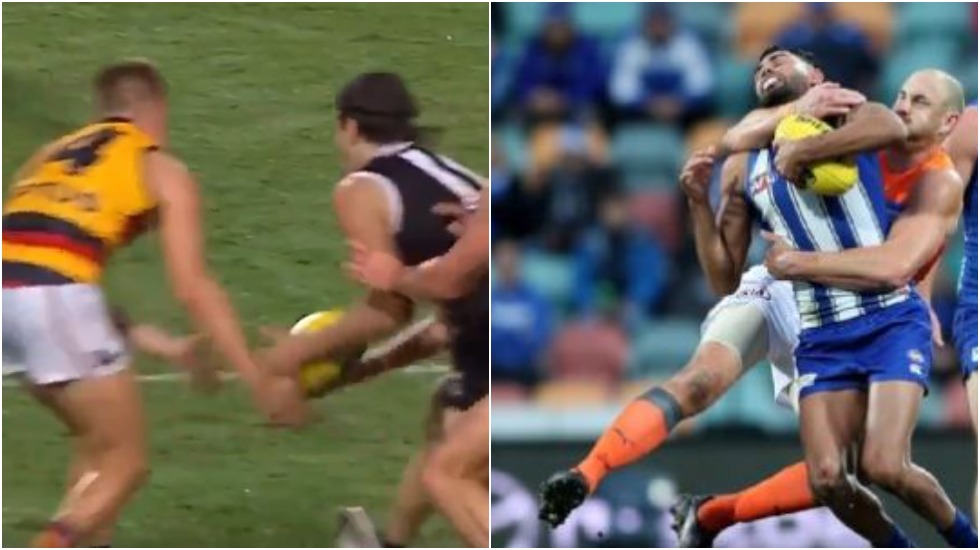
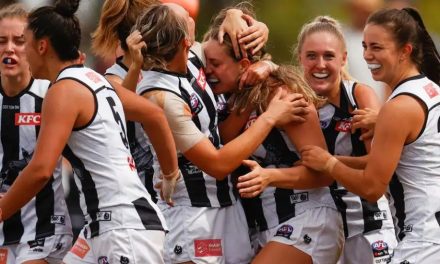
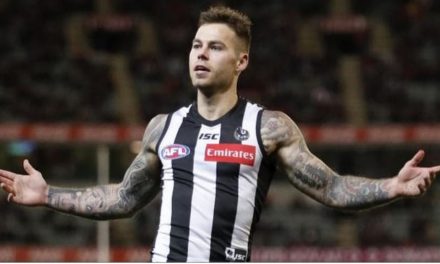
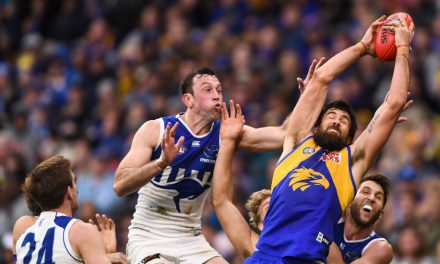
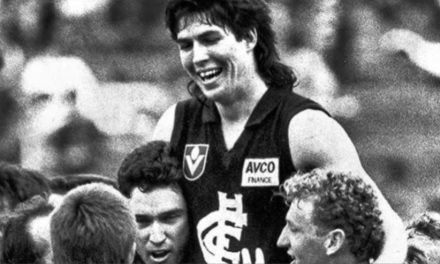






Couldn’t agree more, Rohan. Outcomes are one thing, but surely the intent is the real issue and should be the deciding factor. The perpetrator’s “luck” that an injury didn’t occur, whether serious or not, shouldn’t be the reason he is – or isn’t – punished. Mumford deserved to go for both of the incidents you highlighted, along with several of his other “beyond clumsy” indiscretions in the latter years of his career. His minimal contribution to GWS’s football, this year particularly, makes one wonder if these incidences of seemingly picking off influential opposition players are the primary reason he’s still getting a game.
I am with you about a million percent on this Rohan. What infuriates me is that we don’t ever really look to other sports to genuinely fix this stuff. Mackay’s case would also be wobbly for soccer football referees and officials, and it looks like this:
– Careless is when a player shows a lack of attention or consideration when making a challenge or acts without precaution. No disciplinary sanction is needed
– Reckless is when a player acts with disregard to the danger to, or consequences for, an opponent and must be cautioned (yellow card)
– Using excessive force is when a player exceeds the necessary use of force and endangers the safety of an opponent and must be sent off
I appreciate that Australian rules is a far more contact oriented sport than football, but given the impact on Clark (and subsequently St. Kilda), I do think it’s a sending off, despite Mackay’s record and genuine attempt at the ball and general lack of malice. Obviously St. Kilda would still have conspired a way to lose the game (they almost seemed hell-bent on it by the fourth quarter).
Aussie rules fans often blanche at sending offs, citing how many incorrect decisions get made. But when the MRO / tribunal system is so… eccentric in their findings does it make any difference? They’re not exactly pillars of consistency and correctitude. And a yellow / red card system would actually provide some benefit to the team that his infringed (which I think is the massive, aching, ludicrous core of the problem in the current process).
Meanwhile, Mumford should have been penalised out of the game forever ago. There are a few frees / fifties that are just not paid enough, and all of them are also thoroughly covered in association football. Namely: yellow card for persistently infringing the laws of the game; unsportsmanlike conduct and delaying the restart of play.